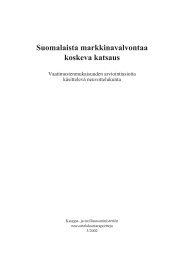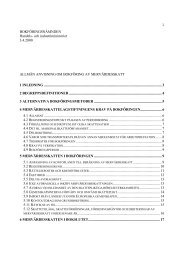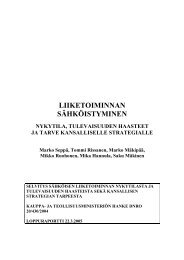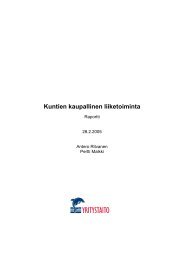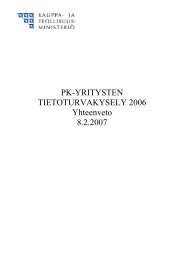Knowledge Intensive Services' Suppliers and Clients
Knowledge Intensive Services' Suppliers and Clients
Knowledge Intensive Services' Suppliers and Clients
Create successful ePaper yourself
Turn your PDF publications into a flip-book with our unique Google optimized e-Paper software.
47<br />
suggests this is a widely shared perception). Within the client, externalisation<br />
may involve the learning that has been achieved as a result of the<br />
interaction with KIBS taking concrete form in mission statements, codified<br />
organisational concepts, new metrics for accounting, new decision<br />
models, etc. A similar process may be underway in the KIBS, too, as it<br />
seeks to reproduce the learning <strong>and</strong> innovations attained through the interaction<br />
with specific clients.<br />
Glückler (1999) <strong>and</strong> Schulz (2000) are among authors who touch on such a cycle of<br />
knowledge generation, noting that consultants learn from the businesses to whom<br />
they supply knowledge. Inter-organisational learning is involved, rather than<br />
one-way knowledge transfer, in many cases. Explicit or, often, implicit knowledge<br />
is “extracted” from the client firm by the KIBS, <strong>and</strong> this knowledge is used in<br />
successive KIBS services, quite possibly including those supplied to other clients.<br />
Den Hertog (2000) also cites the Nonaka & Takeuchi model, suggesting that it<br />
emphases several points relevant to the KIBS-client interface:<br />
• The combination of more tacit <strong>and</strong> explicit, codified forms of<br />
knowledge (information) exchange in organisational learning.<br />
• The role of interaction between team members <strong>and</strong> employees from<br />
various organisations in creating knowledge new to the firm, so that the<br />
knowledge base of the client firm is enriched by confrontation with that<br />
of the KIBS provider.This mainly involves personal interactions<br />
between professionals – thus the client firm must have access to<br />
professionals who can participate in such dialogue.<br />
• The dynamic nature of “knowledge conversion processes” in which<br />
various forms of tacit <strong>and</strong> explicit knowledge are constantly mixed,<br />
redefined, linked, exchanged, reshaped <strong>and</strong> enriched as KIBS <strong>and</strong> their<br />
clients interact. KIBS can trigger <strong>and</strong> strengthen such processes in<br />
clients, acting as catalysts, who help internal communication <strong>and</strong><br />
knowledge conversion. For example, new project teams are set up,<br />
employees are forced to interact, to make tacit knowledge explicit, to<br />
think about new combinations of knowledge <strong>and</strong> rethink their mental<br />
models.<br />
Den Hertog (2000) sees the KIBS-client relationship as varying along several<br />
dimensions, among which that of explicit/codified knowledge versus<br />
tacit/non-codified knowledge is but one important case. Though there is rarely a<br />
price tag on exchange of tacit forms of knowledge, they are at least as important in




